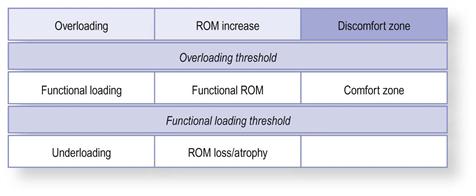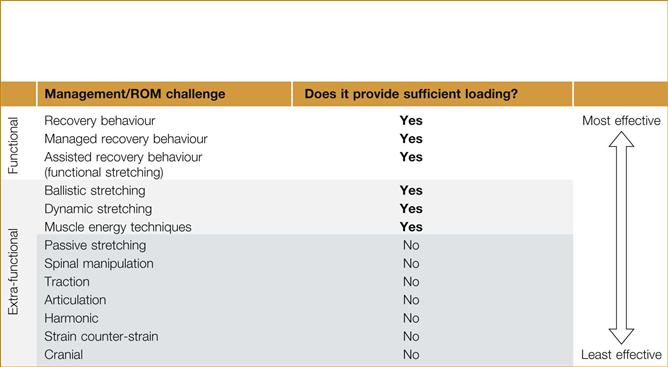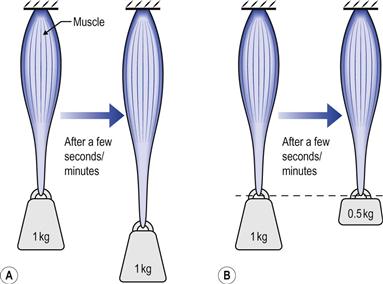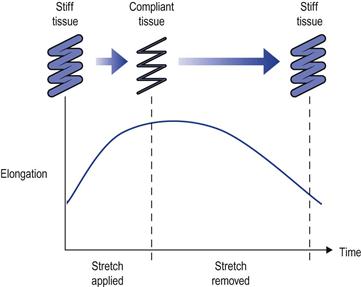The Overloading Condition for Recovery
To write this book I have spent many hours sitting over several years, in mostly flexed slouched position. Yet, the flexion range of my back has remained unchanged. Nor do prolonged weight-bearing activities such as standing result in permanent flattening of the medial arches of my feet. In these and many other postural activities, prolonged high levels of stresses are imposed on the body, yet range of movement (ROM) does not seem to increase. If such levels of postural stress do not bring about a permanent range change why should we expect it to occur by manual stretching or exercise? Yet, paradoxically, yoga practitioners and ballet dancers seem to overcome this physiological barrier to gain remarkable flexibility. Is there something we can learn from them?
This chapter will explore the overloading condition for tissue adaptation, including:
 What force levels drive tissue adaptation?
What force levels drive tissue adaptation?
 How much force is required to maintain the functional ROM?
How much force is required to maintain the functional ROM?
 How much force is required during ROM rehabilitation?
How much force is required during ROM rehabilitation?
 What are the safe levels of force during stretching? Can they be assessed?
What are the safe levels of force during stretching? Can they be assessed?
 Can manual therapy techniques provide sufficient forces for long-term flexibility?
Can manual therapy techniques provide sufficient forces for long-term flexibility?
Loading Levels and Thresholds
Long ago, I trained in martial arts and later as a yoga teacher – two disciplines that required a high level of flexibility. The magnitude of force seems to have played an important role in this training. A full forward bending was achieved by pulling forcefully on my feet while the instructor sat on my back. That seemed to have worked well. From just being able to touch my knees, I was able to bend my back and flatten my chest against my outstretched legs, amongst other great feats of agility. These gains in flexibility took several months to attain and several years to perfect. This personal experience suggests that, for effective long-term tissue elongation, the force of ROM challenges must be above the forces imposed by normal functional demands. Otherwise, we would gradually be turned into dysfunctional hyperflexible masses by the daily stresses imposed on our bodies. This experience also suggests that force interacts with the duration and frequency of stretching. This will be discussed in Chapter 7.
From the example above we can start exploring the forces that are required for tissue adaptation (Fig. 6.1). The first premise is that the functional ROM is maintained by the forces imposed on the body by daily activities, termed here functional loading forces. In order to increase performance/conditioning beyond the daily defaults, the intensity of the activity has to increase – overloading. For example, in the Achilles tendon, adaptation is only observed when loading forces exceed the normal daily values.1 Forces below the functional level, underloading, result in atrophy and loss of ROM.2 Between the functional and overloading levels is an overloading threshold. Between the functional and underloading levels is a functional threshold. So daily activity maintains functional ROM. To increase ROM the forces have to reach some overloading threshold, whereas reducing physical activities below the functional threshold will result in deconditioning.
The question that arises is how do we assess loading levels? Where is the threshold? Is there a way to identify it? Unfortunately, such an assessment is clinically improbable. The main feedback or guidance for loading is ultimately discomfort. As discussed in Chapter 2, functional activities are mostly performed within a comfortable movement range (comfort zone) (Fig. 6.1), whereas overloading is often associated with some level of discomfort. It is often our main feedback during exercise but also during ROM challenges: we assume that patient discomfort represents the point at which overloading takes place. As will be discussed later in this chapter and in Chapter 9, discomfort is an imperfect and inaccurate guide, but there is little else we can use to estimate loading levels.
Overloading in relation to ROM loss and recovery
It is well established that in frozen shoulder the patient will recover their ROM over time and without assistance.3 This means that range improvement is possible by performing functional tasks, but where is the overloading threshold in this recovery?
There is the possibility that lower loading thresholds are required when ROM losses are present. In contractures, the restricted end-range may represent a lowered functional threshold. This means that normal daily activities that require greater ROM may provide the forces and ranges necessary to challenge this threshold (Fig. 6.2). For example, in the ankle during walking, the normal total dorsiflexion and plantarflexion range is about 30°.4 If, because of contractures, this range drops to, say, 20°, this would represent a lowered functional threshold. In this situation, walking, which requires 30°, may generate sufficient loading forces to challenge the limited range. Walking on a steep, sloped surface and stairs could further raise the functional loading levels.4,5
In the presence of ROM losses there is often a shift in the discomfort zone to include the functional range of activities (Fig. 6.2). In the example above, the ROM losses in the ankle are likely to be accompanied by discomfort during functional activities such as walking or climbing stairs. The patient should be made aware that this is normal and even desirable.
Impediments to overloading
Sensitivity/pain and failure to provide sufficient force are common factors that may interfere with overloading during ROM rehabilitation.
ROM losses are often accompanied by pain and anxieties about movement (Chs 9 and 10). Under these circumstances, the patient may terminate the stretching well before it reaches the necessary loading thresholds. This can be resolved partly by dissociating the discomfort from the damage and by focusing on alleviating pain levels before commencing the ROM challenge programme (Ch. 9). For example, in frozen shoulder, the ROM challenges can start when the condition is no longer in the painful phase.
Another impediment is related to the failure of many traditional stretching approaches to generate sufficient forces to reach the loading thresholds (Table 6.1). For example, techniques such as side-lying flexion articulation or manipulation of the spine are unlikely to result in any permanent increase in range (except for the inconsequential elongation discussed below). Such manually applied forces are nowhere close to those imposed by bending and lifting or sitting. The capsular ligaments of the apophyseal joints can by themselves support twice the body weight.6 Failure to generate sufficient forces can be encountered elsewhere in the body. The Achilles tendon or the plantar fascia can withstand considerable forces during functional activities. In walking, the vertical forces on the foot are 1–1.5 times the body weight, in running 2–3 times the body weight and during a triple jump 7–12 times the body weight.7,8 A therapist is likely to injure their hands long before the functional thresholds are reached during stretching. In patients with adaptive ROM losses, the practical solution is to exploit daily activities and to amplify them to provide the necessary loading forces (Ch. 12).
On the lower spectrum of loading inefficacy are manual therapy approaches that use minimal force to promote long-term tissue changes. They include techniques such as strain counter-strain and craniosacral and facial unwinding techniques. In cranial approaches, it is believed that the position and movement of the cranial bones can be modified by gentle manual handling/holding of the head. If such forces were effective then wearing a hat or resting the head on a pillow would result in serious distortions of the skull – if it does not happen by (recurrent) functional stresses, it will not happen by weaker (occasional) manual forces.
The “inconsequential” elongation
Try this home experiment: stretch your index finger into full extension and maintain that angle. After a short while you will experience a certain “give” in resistance. When this happens the joint can be stretched further without any additional force (creep deformation; Fig. 6.3A) or maintained at the same position with less force (force relaxation; Fig 6.3B).9–15 This drop in resistance is related to a biomechanical property of muscle and connective tissues called viscoelasticity.16–18 Musculoskeletal tissues are composed of fibres embedded within a viscous, gel-like medium.14,15,19–22 The fibrous elements provide strength and resistance during loading. The viscous gel elements endow the tissues with a slow, flow-like elongation experienced during stretching (Box 6.1).23
Creep deformation and force relaxation can be observed during all forms of tensional loading.24,25 During sustained muscle stretching creep deformation accounts for 75–85% of the elongation that occurs within the first 15–20 seconds.23 In cyclical stretching about 80% of the elongation will take place in the first four repetitions.19,26 This is often experienced during stretching exercise; most of the range gains occur within the first three or four repetitions, after which the range gains tend to plateau. Force relaxation has been demonstrated in the anterior longitudinal ligament of the spine and during sustained dorsiflexion of the ankle. The force needed to maintain the longitudinal ligament at a given tension halved within the first minute of loading.16 In the ankle joint it takes about 5 minutes to achieve full force relaxation.27
The viscoelastic behaviour of tissues can be deceptive to the therapist and patient. It gives the impression that stretching culminates in longer fibres. However, the immediate change in ROM during stretching is not due to true length changes in the tissue. All that happens is that the tissue has transformed from a stiff into a “softer”, more compliant spring, which means that for a given force it can extend further (Fig. 6.4). These viscoelastic changes in the tissue are transient. At the termination of stretching the tissues will gradually return to their original biomechanical/structural state (Fig. 6.4). The rate at which this recovery occurs varies between tissues. In the hamstrings force relaxation recovers within an hour, whereas in the Achilles tendon it will take several hours.9–11,27–29
Stay updated, free articles. Join our Telegram channel

Full access? Get Clinical Tree








